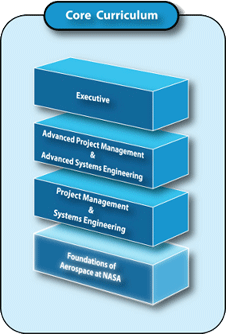September 29, 2009 Vol. 2, Issue 9
Ten centers. Four mission directorates. A host of mission support organizations. Eighteen thousand civil servants, and tens of thousands more contractors. Even with an organization chart, it is not readily apparent how all the pieces fit together. How does a new employee learn to navigate this environment?
NASA is a complex organization with a unique mission, culture, history, and way of doing business. It is also an agency that demands teamwork — one of the agency’s core values, along with safety, integrity, and mission success. How does an individual become an effective team member at NASA?
The Academy of Program/Project & Engineering Leadership set out to help address these questions in 2004-2005, while NASA was engaged in “return to flight” activities after the space shuttle Columbia accident. In its final report, the Columbia Accident Investigation Board had found that “lapses in communication made it difficult for engineers to raise concerns or understand decisions.” In response, the Academy, in collaboration with NASA senior leaders, sought to ensure that new employees would have an opportunity to learn skills in effective teamwork and communication early in their careers.
 Foundations of Aerospace at NASA is a 2-week course designed to address these and other questions about the big picture at NASA. As the first course in the Academy’s multi-level core curriculum, “Foundations” serves as a professional development stepping-stone, offering an agency-wide perspective well beyond the scope of a centers orientation training course.
Foundations of Aerospace at NASA is a 2-week course designed to address these and other questions about the big picture at NASA. As the first course in the Academy’s multi-level core curriculum, “Foundations” serves as a professional development stepping-stone, offering an agency-wide perspective well beyond the scope of a centers orientation training course.
“It gives the people here a broader vision of what’s going on out there,” said Debra Randall, a 12-year NASA veteran at Dryden Flight Research Center who took the course in 2009. “It helps us understand why we’re doing what we’re doing.”
Topics covered include the agency’s strategic goals and objectives, governance model, organizational structure, facilities, and key programs and projects. “The general NASA workforce doesn’t have a complete handle on all the organization and procedures and directives that are out there,” said Aaron Weaver, a biomedical engineer at Glenn Research Center who began his career as a student “co-op” (Cooperative Education Program) in 1999 and returned to NASA as a full-time employee in 2008 after completing graduate school.
The course also provides technical training in the basics of NASA’s aerospace mission and systems and the fundamentals of aeronautics as well as skills training in communications and working as a team member at NASA. “Even though I’d had a lot of aerospace training in college, the course covered a lot of aircraft and spacecraft material geared more toward NASA applications that we weren’t taught in school,” said Vijay Shravah, a mission assurance engineer supporting the Launch Services Program at Kennedy Space Center. Shravah, a 2006 aerospace engineering graduate who came to NASA from a private sector aerospace company, had been at the agency for about a year when he took the course.
“Foundations” took shape after the Academy conducted extensive interviews with the mission directorates, the training officers at NASA’s centers, and senior leaders who felt strongly that the agency needed to do a better job preparing its technical workforce. One conclusion from these conversations was that “Foundations” had to be taught by NASA employees, including senior leaders — “for NASA, by NASA.” As a result, it is not uncommon for Mission Directorate Associate Administrators or the NASA Chief Engineer to serve as lecturers and answer questions about the roles of their respective offices. The External Relations Office teaches a segment on working with international partners and complying with International Traffic in Arms Regulation (ITAR). Members of the NASA History Office teach a popular segment on NASA history that focuses on practical knowledge that employees can use from the agency’s storied past.
The course has run at multiple NASA centers since 2006, and it has become a fixture across the agency — for example, each new employee at Kennedy Space Center now takes “Foundations.” As NASA’s role in addressing national needs continues to grow and change, “Foundations” provides a guide to help NASA employees understand where the organization is today and where it is headed tomorrow.





